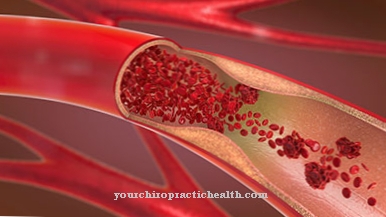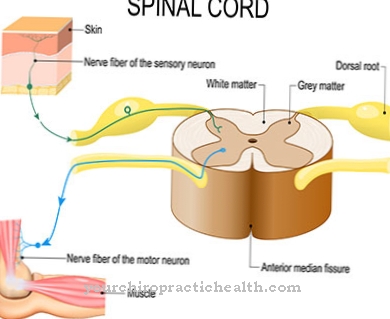Under the term Retroperitoneal fibrosis (also known as retroperitoneal Fibrosis, Ormond Syndrome or Ormond's disease) the doctor describes an increase in connective tissue that occurs between the spine and the posterior peritoneum. Mainly the nerves, ureters and blood vessels are "walled up".
What is retroperitoneal fibrosis?

© anamejia18 - stock.adobe.com
The Retroperitoneal fibrosis is a relatively rare disease (1 in 200,000), but it predominantly affects men. The first signs of retroperitoneal fibrosis appear in middle age. Retroperitoneal fibrosis is further divided into two forms: the idiopathic (primary) and secondary form (Ormond Syndrome). In the primary form, which is also called Ormond's disease or Albarran-Ormond Syndrome is known, there is no triggering event.
Doctors sometimes assume that an autoimmunological process was the cause of the development. In the context of the secondary form (also known as Ormond syndrome), retroperitoneal fibrosis is sometimes triggered by primary biliary cirrhosis, Crohn's disease or Sjögren's syndrome, Erdheim-Chester disease or due to granulomatosis or polyangiitis .
Joaquin Albarran, a Cuban urologist, was the first physician to describe the disease in 1905. In 1948 a more extensive description and documentation by John Kelso Ormond, a urologist from the USA, followed.
causes
Even if secondary forms of the disease can sometimes trigger retroperitoneal fibrosis, the actual cause is still unknown. This applies to both forms of retroperitoneal fibrosis.
Symptoms, ailments & signs
The patient usually complains of dull pain that is difficult to localize, but not comparable to colic pain, which is mainly reported in the scrotum, the flanks or in the back. In almost all cases the ureters are walled; this leads to a backlog of urine in the kidneys, so that there is the possibility of hydronphrosis.
Occasionally larger arteries, the aorta, peripheral nerves or the intestinal tract itself, the pancreatic and biliary system and pelvic organs can also be affected. Another sign of retroperitoneal fibrosis is swollen legs; This is because the lymphatic vessels and veins are blocked from draining. In a few cases there are inflammatory or fibrotic changes of the pleura, pericardium, paranasal sinuses, eye sockets, thyroid or mediastinum.
Diagnosis & course of disease
A histology (examination of the fine tissue) is carried out so that retroperitoneal fibrosis can be detected. Sometimes, however, imaging procedures can give clear indications that retroperitoneal fibrosis is present. Confirmation of the diagnosis, which only exists on the basis of imaging procedures, is permitted if a tissue sample would bring too high a risk.
The examination using magnetic resonance imaging or computed tomography already shows in many cases a clear change in the connective tissue around the aorta (significant increase). Renal arteries or directly adjacent structures can also be affected.
However, if the doctor recognizes atypical features (displacement symptoms, enlargement of the lymph nodes, atypical location), a tissue sample must be taken. This is so that any granulomatous or malignant processes can be excluded.
The patients usually respond well to immunosuppressive therapy. However, since no actual therapy recommendation has been made so far, each case must be individually observed, analyzed and subsequently treated. However, once healed, there is a possibility that retroperitoneal fibrosis may recur.
It is possible that kidney damage may occur during retroperitoneal fibrosis due to the congestion of urine. The mortality (mortality) is between 10 percent and 20 percent; According to the latest findings and studies, however, the mortality rate is already below 10 percent, so that nowadays a significantly better chance of recovery must be assumed.
Complications
Retroperitoneal fibrosis is a serious autoimmune disease that can be accompanied by several complications. Most complications result from the compression of organs resulting from increased fibrous regeneration of connective tissue. Immunosuppressive therapy usually responds very well. But if this is not done long enough, there is often a relapse.
However, complications can only be prevented with the help of such therapy. The kidneys, ureters, aorta abdominalis, the common iliac artery, and the inferior vena cava are often affected by compression. The compression of the ureters can lead to a backlog of urine, which in the long term damages the kidneys. As a result, urinary tract infections and inflammation of the kidneys often develop, which can only be treated with antibiotics. The accumulation of urine leads to severe kidney damage in the long term, which in very severe cases even makes a kidney transplant necessary.
It is also not uncommon for the intestines to be affected. The increased growth of the connective tissue can make it narrower. There is a risk of developing an intestinal obstruction, which must be treated immediately with surgery to prevent large parts of the intestine from dying off. Furthermore, thromboses can form due to the compression of large veins and the associated blood flow disorders, which can only be broken down with the help of blood-thinning medication.
When should you go to the doctor?
Retroperitoneal fibrosis should always be treated by a doctor. This disease does not self-heal and in most cases the symptoms worsen significantly. Retroperitoneal fibrosis cannot be treated by means of self-help either, so that a medical examination is always necessary.
In the case of retroperitoneal fibrosis, the doctor should be consulted if the patient suffers from severe pain in the scrotum. The pain can also occur on the back or on the flanks and significantly reduce the quality of life of the person affected. Furthermore, swollen legs of the patient can indicate retroperitoneal fibrosis; the swelling should be examined by a doctor if it occurs over a longer period of time and does not go away on its own.
In most cases, retroperitoneal fibrosis can be diagnosed and treated by a general practitioner or urologist.
Treatment & Therapy
So far there have been no controlled studies of any treatments or therapeutic approaches. This is because retroperitoneal fibrosis occurs relatively rarely. Due to the rarity, the recommendations are mainly based on the results of smaller case series (case reports); Sometimes the first spontaneous healing (spontaneous remissions) has already been documented.
These spontaneous remissions are the absolute exception. As a rule, the duration of treatment is between 12 and 24 months; a recurrence of retroperitoneal fibrosis cannot be ruled out. If there is a disruption of the urine transport, the doctor must restore the drainage. An internal splint (with a catheter) is placed on the patient during an operation. The ureter may also need to be exposed. In rare cases, such as when a chronic infection has been diagnosed, a kidney must be removed (nephrectomy).
Since there are no actual recommendations as to how retroperitoneal fibrosis should be treated, there are no uniform plans as to which drugs are recommended. However, doctors have found that immunosupressants (azathioprine or corticosteroids) or tamoxifen are particularly promising. Methotrexate, cyclophosphamide, cyclosporin A, mycophenolate mofetil and colchicine have also been used successfully.
Sometimes, however, special treatments may be required if complications occur. Since the intestine is narrowed, an intestinal obstruction is possible. The intestinal obstruction must be treated surgically. If there is a disorder of the urinary flow, a urinary tract infection can occur.
The infection can continue to the renal pelvis (kidney pelvic inflammation), so the patient must be treated with antibiotics. If there is a narrowing of large veins, this can lead to thrombosis or impaired blood flow. In those cases, anticoagulant substances are administered.
prevention
Since no causes are known so far why retroperitoneal fibrosis develops, there are also no preventive measures. However, anyone who suffers from diseases that could be related to retroperitoneal fibrosis should - at the first signs - consult a doctor so that it can be clarified whether or not retroperitoneal fibrosis is present.
Aftercare
In most cases, the affected person has only limited follow-up measures available for retroperitoneal fibrosis. The person concerned should first and foremost consult a doctor very early so that there are no further complications or other complaints for the person concerned. The sooner a doctor is consulted, the more promising the further course of the disease is usually.
Therefore, the person affected should contact a doctor at the first signs of the disease. Most patients with this disease are dependent on an operation, which can relieve the symptoms permanently. After such an operation, the person concerned should definitely rest and take care of his body. Exertion or physical and stressful activities should be avoided in order not to unnecessarily burden the body.
Physiotherapy or physiotherapy may also be necessary, whereby the person affected can perform some of the exercises at home in order to speed up the treatment. Even after a successful procedure, regular check-ups and examinations by a doctor are very important in order to monitor the current status of the retroperitoneal fibrosis. As a rule, this disease does not reduce the patient's life expectancy.
You can do that yourself
In order to improve their quality of life, those affected have to adhere to the medically prescribed dose of cortisone. In the course of the treatment, the body adapts to the dose administered to it and reacts by reducing or stopping the body's own production of cortisone. However, the stress hormone cortisone is vital for the body, as it is involved in many metabolic processes. Sudden discontinuation or a significantly reduced dose can lead to threatening metabolic disorders, severe relapse or even secondary diseases.
All side effects and abnormalities should be noted by the person concerned and passed on to the doctor as part of the regular check-ups. This can react accordingly with an adjusted dose of medication or other prescribed therapeutic agents.
Some sufferers were able to achieve steady improvement through a targeted change in diet to a balanced and healthy diet. Such an adaptation of the nutrition plan can be carried out optimally with the help of a nutritionist and adapted to individual needs. As a result, the immune system is strengthened, excess weight is reduced and the body is supplied with all the minerals and vitamins it needs for a well-functioning metabolism.
Contact with self-help groups can remove uncertainty in dealing with the disease. In conversations you get a lot of experience, doctor recommendations and helpful tips for everyday life and possible further therapies.





.jpg)





















